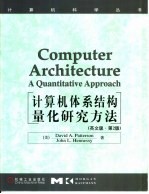图书介绍
计算机体系结构量化研究方法 英文版·第2版pdf电子书版本下载

- (美)DavidA.Patterson等著 著
- 出版社: 北京:机械工业出版社
- ISBN:7111074394
- 出版时间:1999
- 标注页数:1006页
- 文件大小:67MB
- 文件页数:1033页
- 主题词:
PDF下载
下载说明
计算机体系结构量化研究方法 英文版·第2版PDF格式电子书版下载
下载的文件为RAR压缩包。需要使用解压软件进行解压得到PDF格式图书。建议使用BT下载工具Free Download Manager进行下载,简称FDM(免费,没有广告,支持多平台)。本站资源全部打包为BT种子。所以需要使用专业的BT下载软件进行下载。如 BitComet qBittorrent uTorrent等BT下载工具。迅雷目前由于本站不是热门资源。不推荐使用!后期资源热门了。安装了迅雷也可以迅雷进行下载!
(文件页数 要大于 标注页数,上中下等多册电子书除外)
注意:本站所有压缩包均有解压码: 点击下载压缩包解压工具
图书目录
1 Fundamentals of Computer Design 1
References 1
E.1 Implementation Issues for the Snooping Coherence Protocol 1
Appendix E:Implementing Coherence Protocols 1
D.1 Introduction 1
Appendix D:An Alternative to RISC: The Intel 80x86 1
C.1 Introduction 1
Appendix C: Survey of Risc Architectures 1
B.1 Why Vector Processors? 1
Appendix B:Vector Processors 1
A.1 Introduction 1
Xerox Paio Alto Research Center 1
by DAVID GOLDBERG 1
Appendix A: Computer Arithmetic 1
Index 1
1.1 Introduction 1
D.2 80x86 Registers and Data Addressing Modes 2
A.2 Basic Techniques of Integer Arithmetic 2
C.2 Addressing Modes and Instruction Formats 3
1.2 The Task of a Computer Designer 3
B.2 Basic Vector Architecture 3
C.3 Instructions : The DLX Subset 5
E.2 Implementation Issues in the Distributed Directory Protocol 6
1.3 Technology and Computer Usage Trends 6
D.3 80x86 Integer Operations 6
1.4 Cost and Trends in Cost 8
D.4 80x86 Floating-Point Operations 9
C.4 Instructions : Common Extensions to DLX 9
D.5 80x86 Instruction Encoding 11
Exercises 12
C.5 Instructions Unique to MIPS 13
A.3 Floating Point 13
B.3 Two Real-World Issues : Vector Length and Stride 15
C.6 Instructions Unique to SPARC 15
D.6 Putting It All Together : Measurements of Instruction Set Usage 15
A.4 Floating-Point Multiplication 17
C.7 Instructions Unique to PowerPC 18
1.5 Measuring and Reporting Performance 18
C.8 Instructions Unique to PA-RISC 19
D.7 Concluding Remarks 22
B.4 Effectiveness of Compiler Vectorization 22
A.5 Floating-Point Addition 22
C.9 Concluding Remarks 22
B.5 Enhancing Vector Performance 23
D.8 Historical Perspective and References 23
C.10 References 25
A.6 Division and Remainder 28
B.6 Putting It All Together : Performance of Vector Processors 29
1.6 Quantitative Principles of Computer Design 29
A.7More on Floating-Point Arithmetic 34
B.7 Fallacies and Pitfalls 35
B.8 Concluding Remarks 37
A.8 Speeding Up Integer Addition 38
B.9 Historical Perspective and References 38
1.7 Putting it All Together:The Concept of Memory Hierarchy 39
Exercises 43
1.8 Fallacies and Pitfalls 44
A.9 Speeding Up Integer Multiplication and Division 46
1.9 Concluding Remarks 51
1.10 Historical Perspective and References 53
Exercises 60
A.10 Putting It All Together 61
A.11 Fallacies and Pit?alls 65
A.12 Historical Perspective and References 68
2.1 Introduction 69
2 Instruction Set Principles and Examples 69
2.2 Classifying Instruction Set Architecfures 70
Exercises 72
2.3 Memory Addressing 73
2.4 Operations in the Instruction Set 80
2.5 Type and Size of Operands 85
2.6 Encoding an Instruction Set 87
2.7 Crosscutting Issues:The Role of Compilers 89
2.8 Putting it All Together : The DLX Architecture 96
2.9 Fallacies and Pitfalls 108
2.10 Concluding Remarks 111
2.11 Historical Perspective and References 112
Exercises 118
3.1 What Is Pipelining? 125
3 Pipellning 125
3.2 The Basic Pipeline for DLX 132
3.3 The Major Hurdle of Pipelining ——Pipeline Hazards 139
3.4 Data Hazards 146
3.5 Control Hazards 161
3.6 What Makes Pipelining Hard to Implement? 178
3.7 Extending the Dlx Pipeline to Handle Multicycle Operations 187
3.8 Crosscutting Issues : Instruction Set Design and Pipelining 199
3.9 Putting It All Together: The MIPS R4000 Pipeline 201
3.10 Fallacies and Pitfalls 209
3.11 Concluding Remarks 211
3.12 Historical Perspective and References 212
Exercises 214
4.1 Instruction-Level Parallelism : Concepts and Challenges 221
4 Advanced Pipelining and Instruction-Level Parallelism 221
4.2 Overcoming Data Hazards with Dynamic Scheduling 240
4.3 Reducing Branch Penalties with Dynamic Hardware Prediction 262
4.4 Taking Advantage of More ILP with Multiple Issue 278
4.5 Compiler Support for Exploiting ILP 289
4.6 Hardware Support for Extracting More Parallelism 299
4.7 Studies of ILP 317
4.8 Putting It All Together : The PowerPC 620 335
4.9 Fallacies and Pitfalls 349
4.10 Concluding Remarks 352
4.11 Historical Perspective and References 354
Exercises 362
5.1 Introduction 373
5 Memory-Hierarchy Design 373
5.2 The ABCs of Caches 375
5.3 Reducing Cache Misses 390
5.4 Reducing Cache Miss Penalty 411
5.5 Reducing Hit Time 422
5.6 Main Memory 427
5.7 Virtual Memory 439
5.8 Protection and Examples of Virtual Memory 447
5.9 Crosscutting Issues in the Design of Memory Hierarchies 457
5.10 Putting It All Together: The Alpha AXP 21064 Memory Hierarchy 461
5.11 Fallacies and Pitfalls 466
5.12 Concluding Remarks 471
5.13 Historical Perspective and References 472
Exercises 476
6.1 Introduction 485
6 Storage Systems 485
6.2 Types of Storage Devices 486
6.3 Buses-Connecting I/O Devices to CPU/Memory 496
6.4 I/O Performance Measures 504
6.5 Reliability, Availability, and RAID 521
6.6 Crosscutting Issues : Interfacing to an Operating System 525
6.7 Designing an I/O System 528
6.8 Putting It All Together: UNIX File System Performance 539
6.9 Fallacies and Pitfalls 548
6.10 Concluding Remarks 553
6.11Historical Perspective and References 553
Exercises 557
7 Interconnection Networks 563
7.1 Introduction 563
7.2 A Simple Network 565
7.3 Connecting the Interconnection Network to the Computer 573
7.4 Interconnection Network Media 576
7.5 Connecting More Than Two Computers 579
7.6 Practical Issues for Commercial Interconnection Networks 597
7.7 Examples of Interconnection Networks 601
7.8 Crosscutting Issues for Interconnection Networks 605
7.9 Intemetworking 608
7.10 Putting It All TOgether : An ATM Network of Workstations 613
7.11 Fallacies and Pitfalls 622
7.12 Concluding Remarks 625
7.13 Historical Perspective and References 626
Exercises 629
8 Multiprocessors 635
8.1 Introduction 635
8.2 Characteristics of Application Domains 647
8.3 Centralized Shared-Memory Architectures 654
8.4 Distributed Shared-Memory Architectures 677
8.5 Synchronization 694
8.6 Models of Memory Consistency 708
8.7 Crosscutting Issues 721
8.8 Putting It All Together : The SGI Challenge Multiprocessor 728
8.9 Fallacies and Pitfalls 734
8.10 Concluding Remarks 740
8.11 Historical Perspective and References 745
Exercises 755